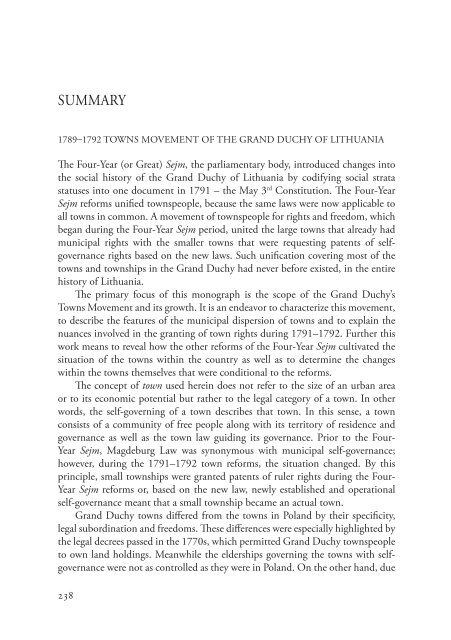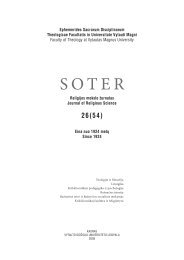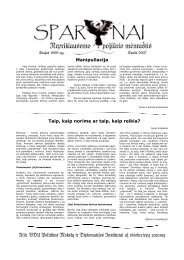Untitled - Vytauto Didžiojo universitetas
Untitled - Vytauto Didžiojo universitetas
Untitled - Vytauto Didžiojo universitetas
You also want an ePaper? Increase the reach of your titles
YUMPU automatically turns print PDFs into web optimized ePapers that Google loves.
SUMMARY<br />
1789–1792 TOWNS MOVEMENT OF THE GRAND DUCHY OF LITHUANIA<br />
The Four-Year (or Great) Sejm, the parliamentary body, introduced changes into<br />
the social history of the Grand Duchy of Lithuania by codifying social strata<br />
statuses into one document in 1791 – the May 3 rd Constitution. The Four-Year<br />
Sejm reforms unified townspeople, because the same laws were now applicable to<br />
all towns in common. A movement of townspeople for rights and freedom, which<br />
began during the Four-Year Sejm period, united the large towns that already had<br />
municipal rights with the smaller towns that were requesting patents of selfgovernance<br />
rights based on the new laws. Such unification covering most of the<br />
towns and townships in the Grand Duchy had never before existed, in the entire<br />
history of Lithuania.<br />
The primary focus of this monograph is the scope of the Grand Duchy’s<br />
Towns Movement and its growth. It is an endeavor to characterize this movement,<br />
to describe the features of the municipal dispersion of towns and to explain the<br />
nuances involved in the granting of town rights during 1791–1792. Further this<br />
work means to reveal how the other reforms of the Four-Year Sejm cultivated the<br />
situation of the towns within the country as well as to determine the changes<br />
within the towns themselves that were conditional to the reforms.<br />
The concept of town used herein does not refer to the size of an urban area<br />
or to its economic potential but rather to the legal category of a town. In other<br />
words, the self-governing of a town describes that town. In this sense, a town<br />
consists of a community of free people along with its territory of residence and<br />
governance as well as the town law guiding its governance. Prior to the Four-<br />
Year Sejm, Magdeburg Law was synonymous with municipal self-governance;<br />
however, during the 1791–1792 town reforms, the situation changed. By this<br />
principle, small townships were granted patents of ruler rights during the Four-<br />
Year Sejm reforms or, based on the new law, newly established and operational<br />
self-governance meant that a small township became an actual town.<br />
Grand Duchy towns differed from the towns in Poland by their specificity,<br />
legal subordination and freedoms. These differences were especially highlighted by<br />
the legal decrees passed in the 1770s, which permitted Grand Duchy townspeople<br />
to own land holdings. Meanwhile the elderships governing the towns with selfgovernance<br />
were not as controlled as they were in Poland. On the other hand, due<br />
238





